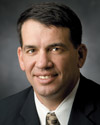Despite a recession that has deeply affected the bottom lines of even the country’s strongest construction firms, specialty contracting giant EMCOR Group, Norwalk, Conn., still managed a monster year in 2009, reporting $5.5 billion in worldwide revenue and nearly $700 million in the New York region. But as the EMCOR plots its way forward in a still-uncertain market, they’ll be doing it without its CEO Frank MacInnis, who announced earlier this year that he will retire at the beginning of 2011 after a successful 16-year run that saw the company grow by nearly $4 billion.
Replacing MacInnis will be Tony Guzzi, currently the firm’s president and chief operating officer, who currently oversees EMCOR’s day-to-day operations. Guzzi recently participated in a conference call with several McGraw-Hill Construction editors from around the country.
McGraw-Hill Construction: How has EMCOR been dealing with the current market? What are you seeing out there?
Tony Guzzi: EMCOR came through 2009 in really good shape, by any metric – record margins on the operating side with our mix of businesses. We really reduced our break-even point quite significantly, and we benefited from a lot of the productivity investments we made in the upturn, and the restructuring we did of operations in the upturn. We exited some sectors, domestically and internationally, that we don’t want to be in any more. And we invested in other ones. We’ve made some key hires. As other people shed work and great people, we have upgraded talent in some cases.

GUZZI
What’s happened is, in the battleground – the $2 to $10 million markets – people began irrational bidding and starting to work for cash flow. Twelve to 15 GCs or CMs, and anywhere from 12 to 20 specialty subs showing up on a job, and people breaking one of the cardinal rules for a specialty sub of traveling into an area you don’t know anything about. That can’t bode well for them long term. There may be an expertise they don’t have or a geographic area they don’t know how to operate in.
MHC: There was a report recently that EMCOR was sitting on $625 million in cash. Are you looking to use this cash for additional acquisitions?
TG: We always look and never comment on specific acquisitions. When you think about where we would look and how we look – we always look to add to our construction capability, but we also look geographically. There are still a few holes in the country where EMCOR is not represented in a significant market. We like to buy the number one or number two [firm] in any given market. If we buy the number two, we like to make them a strong contender to the number one. We don’t like to buy fixer uppers and we almost never buy something in a market we are already in. We tend to be fair-value buyers. We’re not the guys who pay the most. We tend to have long-term relationships with people. And for a lot of people, we are the preferred place they want their company to end up.
MHC: Are there ways of stepping in to help or assist the companies once you acquire them?
TG: We want them to be great local operators. We do a lot of resource sharing and lessons learned from the more difficult technical jobs we do. We also help temper some of our local operators’ enthusiasm to take a project a little out of their expertise. We make sure the bidding stays disciplined. We don’t need our guys to work for cash flow. We don’t have to take work for practice right now. We can keep guys from doing that and as the market up turns, they will be thankful we did.
MHC: Earlier you talked about the gaps that you have in certain parts of the country. Where on a regional basis do you see yourself as under-represented?
TG: On the mechanical services side, we are under-represented in the Pacific Northwest and the Rockie Mountain region – small project and technician-based services. We have no representation in Dallas. We’re under represented in some parts of the lower Midwest.
If you flip into the construction side, it’s no secret EMCOR would love to be in the electrical business in New England. There are parts of the Midwest where we still need an electrical presence or mechanical presence in the lower Midwest, cities like St. Louis and others. We could use presence in the Pacific Northwest on the mechanical side, too. There are still a couple of markets out there that we would like to be in.

Post a comment to this article
Report Abusive Comment